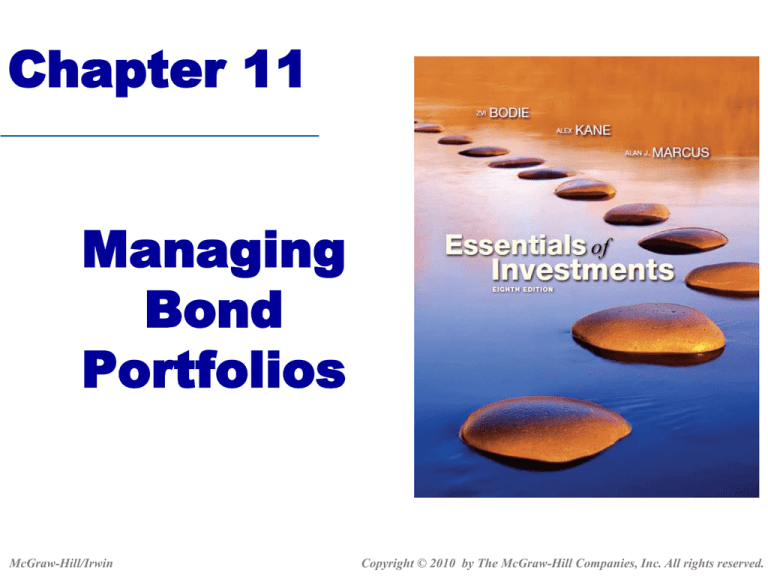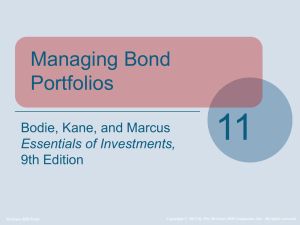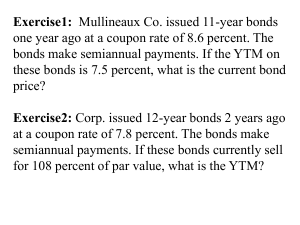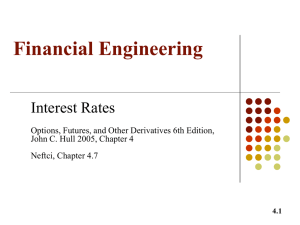
Chapter 11
Managing
Bond
Portfolios
McGraw-Hill/Irwin
Copyright © 2010 by The McGraw-Hill Companies, Inc. All rights reserved.
11.1 Interest Rate Risk
11-2
Interest Rate Sensitivity
1. Inverse relationship between bond price and
interest rates (or yields)
2. Long-term bonds are more price sensitive than
short-term bonds
3. Sensitivity of bond prices to changes in yields
increases at a decreasing rate as maturity
increases
11-3
Interest Rate Sensitivity (cont)
4. A bond’s price sensitivity is inversely related to
the bond’s coupon
5. Sensitivity of a bond’s price to a change in its
yield is inversely related to the yield to maturity
at which the bond currently is selling
6. An increase in a bond’s yield to maturity results
in a smaller price decline than the gain
associated with a decrease in yield
11-4
Duration
Consider the following 3 year 10% coupon annual
payment corporate bond:
1
•
•
•
•
2
3
$100
$100
$1100
Because the bond pays cash prior to maturity it has an
“effective” maturity less than 3 years.
We can think of this bond as a portfolio of 3 zero
coupon bonds with the given maturities.
The average maturity of the three zeros would be the
coupon bond’s effective maturity.
We need a way to calculate the effective maturity.
11-5
Duration
• Duration is the term for the effective maturity of a bond
• Time value of money tells us we must calculate the
present value of each of the three zero coupon bonds to
construct an average.
• We then need to take the present value of each zero and
divide it by the price of the coupon bond. This tells us
what percentage of our money we get back each year.
• We can now construct the weighted average of the times
until each payment is received.
11-6
Duration Formula
N
CFt
t
(
1
ytm
)
Wt t 1
Pr ice
N
Dur Wt t
t 1
Wt = Weight of time t, present value of the cash
flow earned in time t as a percent of the
amount invested
CFt = Cash Flow in Time t, coupon in all periods
except terminal period when it is the sum of
the coupon and the principal
ytm = yield to maturity; Price = bond’s price
Dur = Duration
11-7
Calculating the duration of a 10% coupon, 8% yield, 3 year
annual payment bond
Par =
Coupon
Term
Yield
Year
1
2
3
Price =
1000
10.00%Or $100.00
3
8%
Coupon
100.00
100.00
100.00
Par
1,000.00
1,051.54 Duration=
Total CF
PVIF PV of CF Weight
100.00 0.9259
92.59
8.81%
100.00 0.8573
85.73
8.15%
1,100.00 0.7938
873.22
83.04%
Sum: 1,051.54
2.74years
Wt*t
0.0881
0.1631
2.4912
2.7424
Using Excel to Calculate Duration
Excel can be used to calculate a bond’s
duration.
Usage notes:
•The dates should be entered using the formulas given
•If you don’t know the actual settlement date and maturity date, set the 6th term
in the duration formulae to 0 as shown and pick a maturity date with the same
month and day as the settlement date and the correct number of years after the
settlement date.
•The par is not needed
11-9
More on Duration
1. Duration increases with maturity
2. A higher coupon results in a lower duration
3. Duration is shorter than maturity for all bonds except
zero coupon bonds
4. Duration is equal to maturity for zero coupon bonds
5. All else equal, duration is shorter at higher interest rates
6. The duration of a level payment perpetuity is
Dperpetuity
1 y
;
y
y ytm
11-10
Duration of Portfolio
5. The duration of a portfolio is weighted
average duration of individual securities
6. Example: Two bonds
Bond A
Bond B
Duration
4 years
10 Years
Value of bonds
$10,000
$15,000
Or
40%
60%
Duration of portfolio = .4x4 + .6x10 = 7.6 years
11-11
Example
• Need to have a portfolio of bonds with 5 year duration,
• Available bonds are:
– One zero coupon 3 year bond, Dzero =3
– One perpetual bond; @8% ytm,
Dperp = 1.08/.08= 13.5 yrs
• Dportfolio = Wzx3 + (1-Wz)x13.5 = 5
– Solve for Wz = .81, WB =.19
Duration as a Function of Maturity
11-13
Duration/Price Relationship
• Price change is proportional to duration
and not to maturity
• D = Duration
DP/P = -D x [Dy / (1+y)]
• D* = modified duration
D* = D / (1+y)
DP/P = - D* x Dy
11-14
11.2 Passive Bond Management
11-15
Interest Rate Risk
• Interest rate risk is the possibility that an investor does
not earn the promised ytm because of interest rate
changes.
• A bond investor faces two types of interest rate risk:
– Price risk: The risk that an investor cannot sell the bond for as much as
anticipated. An increase in interest rates reduces the sale price.
Reinvestment risk: The risk that the investor will not be able to reinvest
the coupons at the promised yield rate. A decrease in interest rates
reduces the future value of the reinvested coupons.
• The two types of risk are potentially offsetting.
11-16
Immunization
• Immunization: An investment strategy designed
to ensure the investor earns the promised ytm.
• A form of passive management, two versions
1. Target date immunization
• Attempt to earn the promised yield on the bond
over the investment horizon.
• Accomplished by matching duration of the bond to
the investment horizon
11-17
Immunizing Example
• Planning horizon = 5 years
• Find a bond with 5 year duration
– e.g., 8%, 6 year bond, D = 4.99 year @8% ytm
HOLDING PERIOD RETURN
Yield after purchase
Sold in year
Remaining Maturity
Price of Bond when sold
Year
1
2
3
4
5
Coupon
80.00
80.00
80.00
80.00
80.00
7%
5
1
$1,009.35
Par/Price
1,009.35
Total cash flow at terminal date:
Initial price of the bond
Holding period return
Total CF
80.00
80.00
80.00
80.00
1,089.35
$1,469.40
$1,000.00
8.00%
FVIF
1.3108
1.2250
1.1449
1.0700
1.0000
FV
104.86
98.00
91.59
85.60
1,089.35
1,469.40
Terminal Value of an Immunized
Portfolio over a 5 year Horizon
11-20
Holding Period Return with changes in
Reinvestment Yield
+/- in Yield
-3%
-2%
-1%
0%
1%
2%
3%
New Yield
5%
6%
7%
8%
9%
10%
11%
HPR
8.02%
8.01%
8.00%
8.00%
8.00%
8.01%
8.03%
Immunization
2. Net worth immunization
• The equity of an institution can be
immunized by matching the duration of
the assets to the duration of the liabilities.
11-22
Cash Flow Matching and Dedication
• Cash flow from the bond and the obligation exactly offset
each other
• Automatically immunizes a portfolio from interest rate
movements
• Not widely pursued, too limiting in terms of choice of
bonds
• May not be feasible due to lack of availability of
investments needed
11-23
Problems with Immunization
1. May be a suboptimal strategy
2. Does not work as well for complex portfolios with option
components, nor for large interest rate changes
3. Requires rebalancing of the portfolio periodically, which
then incurs transaction costs
– Rebalancing is required when interest rates move
– Rebalancing is required over time
11-24
11.3 Convexity
11-25
The Need for Convexity
• Duration is only an approximation
• Duration asserts that the percentage price
change is linearly related to the change in
the bond’s yield
– Underestimates the increase in bond prices
when yield falls
– Overestimates the decline in price when the
yield rises
11-26
Pricing Error Due to Convexity
11-27
Convexity: Definition and Usage
n
CFt
1
2
Convexity
(t t )
2
t
P (1 y) t 1 (1 y)
Where: CFt is the cash flow (interest and/or principal) at
time t and y = ytm
The prediction model including convexity is:
DP
Dy
D
1/ 2 Convexity Dy 2
P
(1 y )
11-28
Prediction Improvement With Convexity
11-29
Convexity of Two Bonds
11-30
11.4 Active Bond Management
11-31
Swapping Strategies
1. Substitution swap
– Exchanging one bond for another with very similar
characteristics but more attractively priced
2. Intermarket spread swap
– Exploiting deviations in spreads between two market segments
3. Rate anticipation swap
– Choosing a duration different than your investment horizon to
exploit a rate change.
• Rate increase: Choose D > Investment horizon
• Rate decrease: Choose D < Investment horizon
11-32
Swapping Strategies
4. Pure yield pickup
– Switching to a higher yielding bond, may be longer
maturity if the term structure is upward sloping or
may be lower default rating.
5. Tax swap
– Swapping bonds for tax purposes, for example
selling a bond that has dropped in price to realize a
capital loss that may be used to offset a capital gain
in another security
11-33
Horizon Analysis
• Analyst selects a particular investment period and
predicts bond yields at the end of that period in order to
forecast the bond’s HPY
11-34









